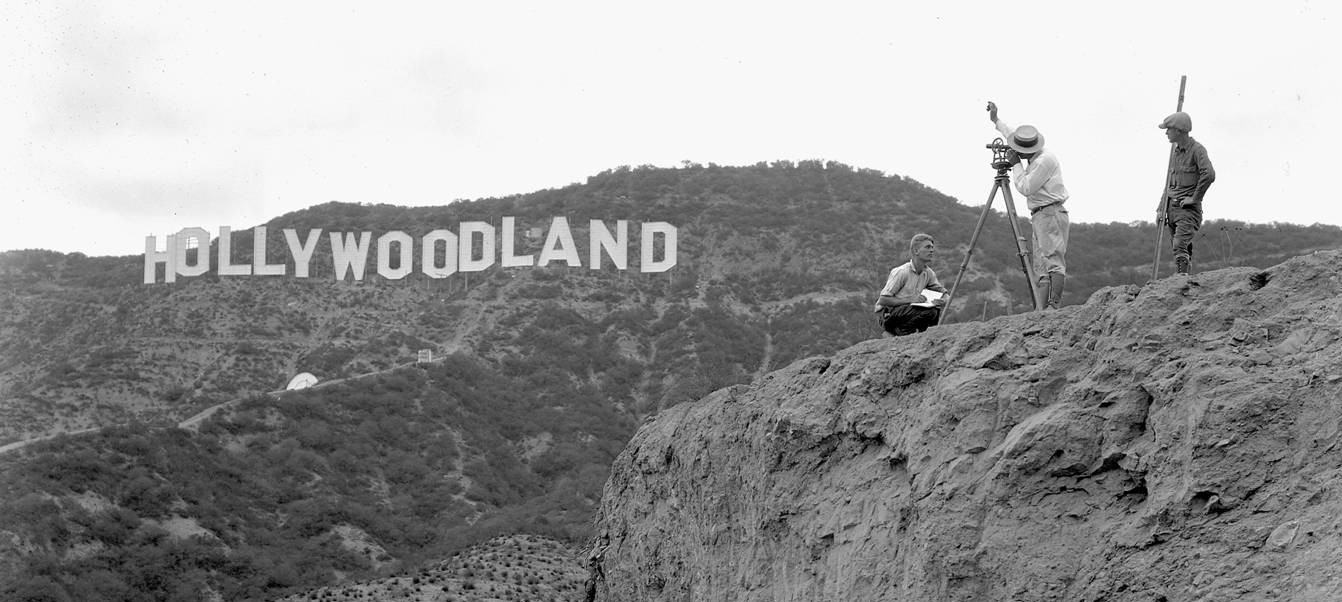How sex scandals, a coin dud and a president’s death created a spectacular failure
This is the story of the greatest failure you’ve never heard of. From start to finish, it was the living embodiment of Murphy’s Law: if anything can go wrong, it will. Little wonder that its organizers tried to erase this fiasco from public memory. But the time has come to revisit the utterly disastrous 1923 World’s Fair.
Hollywood had a huge PR problem on its hands in 1922. The infant movie industry was under attack on every front.
First, there was a seemingly endless string of major scandals.
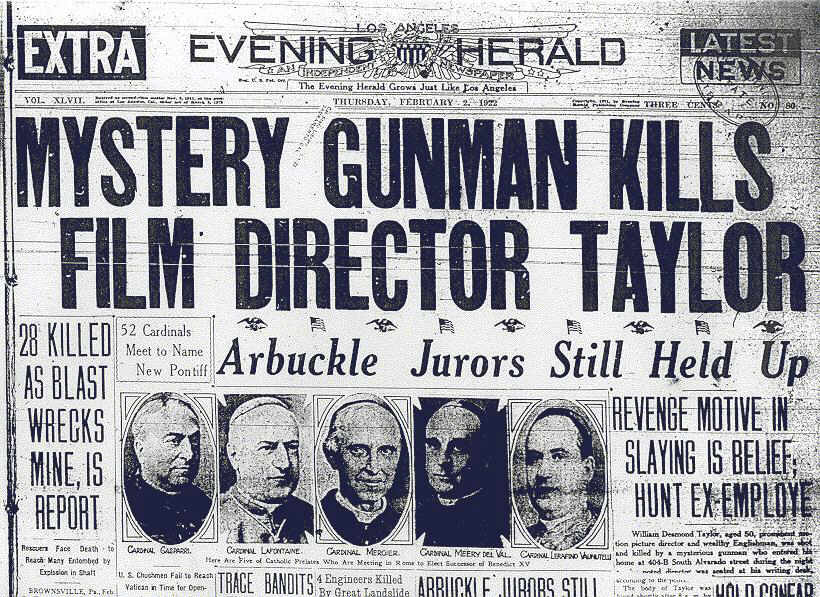 On February 1, leading actor and director William Desmond Taylor was shot and killed in his home. (Imagine the uproar that would erupt if Steven Spielberg were murdered; that’s how huge Taylor’s death was at the time.) The cast of suspects included some of Tinsel Town’s biggest names. Yet to this day, his murderer has never been identified.
On February 1, leading actor and director William Desmond Taylor was shot and killed in his home. (Imagine the uproar that would erupt if Steven Spielberg were murdered; that’s how huge Taylor’s death was at the time.) The cast of suspects included some of Tinsel Town’s biggest names. Yet to this day, his murderer has never been identified.
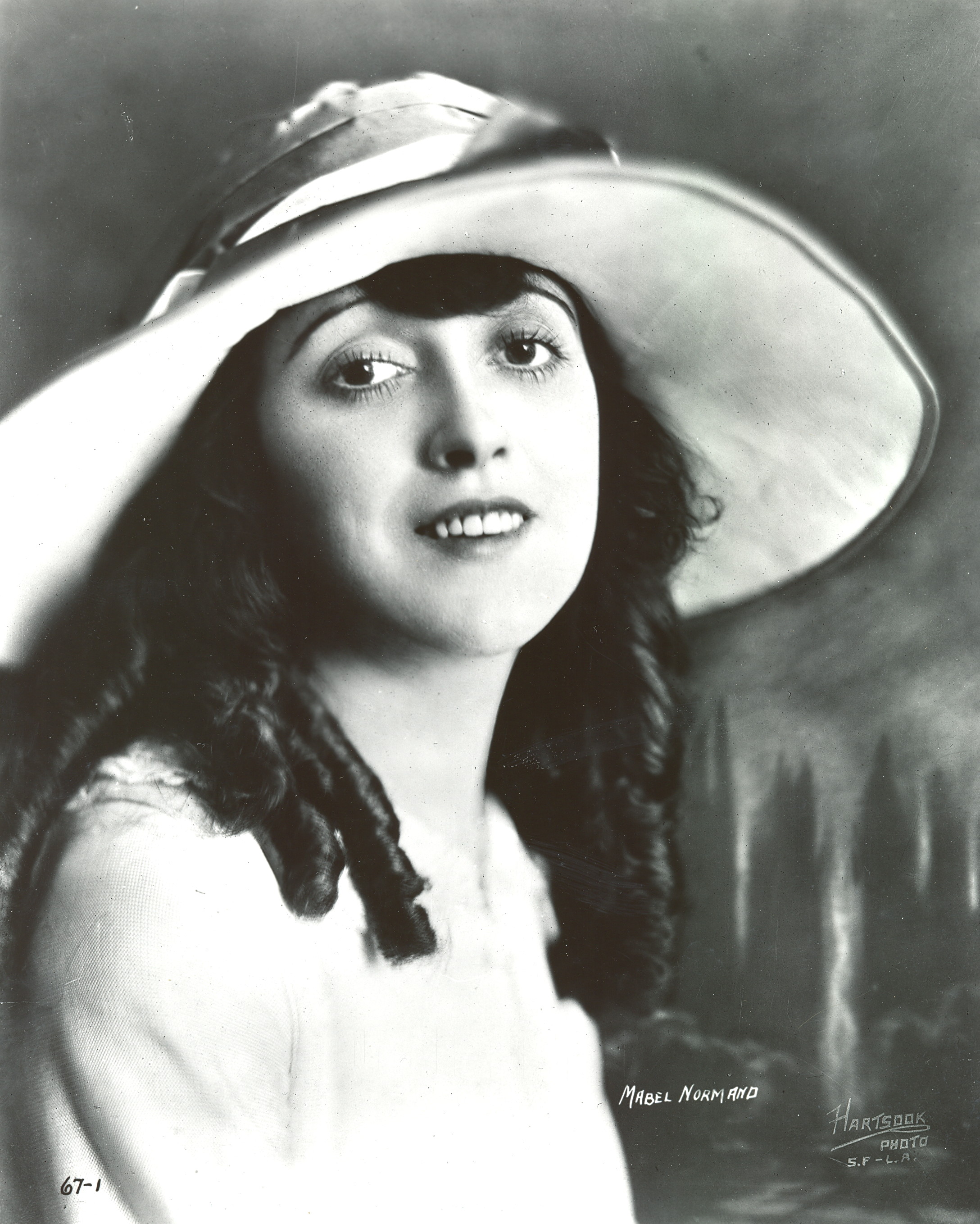 Then there was Mabel Normand, a big box office draw, whose personal life was an ongoing train wreck. She was implicated in Taylor’s death. Her cocaine addiction was notorious – and was growing worse by the month. Her chauffer would even shoot and wound a millionaire oil broker with her pistol a year later.
Then there was Mabel Normand, a big box office draw, whose personal life was an ongoing train wreck. She was implicated in Taylor’s death. Her cocaine addiction was notorious – and was growing worse by the month. Her chauffer would even shoot and wound a millionaire oil broker with her pistol a year later.
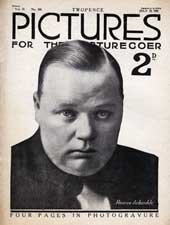 But the biggest scandal of all (pun intended), was Fatty Arbuckle. It’s hard to imagine now, but this 300 pound comedian was a major star in his day, right up there with Charlie Chaplin and Mary Pickford. He was also known for serious drinking and partying. But nobody was laughing when a model-minor movie actress-party girl named Virginia Rappe died after being raped at a drunken sex party in a San Francisco hotel in September 1921. Arbuckle was charged with manslaughter, generating a flood of sensational headlines and even more salacious gossip (his extreme obesity had caused Rappe’s bladder to burst; he had raped her with a Coke bottle, etc.) His 1922 trial revealed a tidal wave of damning insights into Hollywood’s decadent, self-indulgent lifestyle. Although Arbuckle was acquitted in three separate trials, the damage was immense. His career was ruined, and movie moguls feared he would take the entire industry down with him.
But the biggest scandal of all (pun intended), was Fatty Arbuckle. It’s hard to imagine now, but this 300 pound comedian was a major star in his day, right up there with Charlie Chaplin and Mary Pickford. He was also known for serious drinking and partying. But nobody was laughing when a model-minor movie actress-party girl named Virginia Rappe died after being raped at a drunken sex party in a San Francisco hotel in September 1921. Arbuckle was charged with manslaughter, generating a flood of sensational headlines and even more salacious gossip (his extreme obesity had caused Rappe’s bladder to burst; he had raped her with a Coke bottle, etc.) His 1922 trial revealed a tidal wave of damning insights into Hollywood’s decadent, self-indulgent lifestyle. Although Arbuckle was acquitted in three separate trials, the damage was immense. His career was ruined, and movie moguls feared he would take the entire industry down with him.
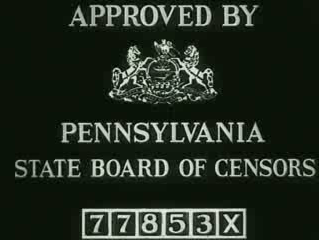 There were signs that just might happen. Across the country, states, counties and cities created censorship boards to screen movies shown locally. Their verdict was unanimous: too much smut, too little virtue and wholesomeness.
There were signs that just might happen. Across the country, states, counties and cities created censorship boards to screen movies shown locally. Their verdict was unanimous: too much smut, too little virtue and wholesomeness.
Finally, the thing moviemakers fear above all others happened. For the first time since recordkeeping began, box office ticket sales dropped in 1922.
The handwriting was clearly on the wall: the industry had to clean up its act – fast.
So Hollywood rolled into action.
 First, it created the Motion Picture Producers and Distributors of America to respond to the threats with a united front. Then, to prove this wasn’t mere window dressing, no-nonsense former U.S. Postmaster General Will Hays was tapped to run it. The so-called Hays Office had to approve all films before their release in a pre-emptive strike aimed at stymying local censorship boards.
First, it created the Motion Picture Producers and Distributors of America to respond to the threats with a united front. Then, to prove this wasn’t mere window dressing, no-nonsense former U.S. Postmaster General Will Hays was tapped to run it. The so-called Hays Office had to approve all films before their release in a pre-emptive strike aimed at stymying local censorship boards.
But that wasn’t enough. The movie industry needed to show Americans that their angst was unfounded. So it responded by doing what Hollywood does best: it put on a show.
And not just any show, either, but the biggest, loudest, flashiest show of all … a world’s fair.
 Hosting one had done wonders for Chicago in 1893 (celebrating the 400th anniversary of Columbus’ discovery of the New World), St. Louis in 1904 (the centennial of the Louisiana Purchase), and San Francisco in 1915 (the highly successful Panama–Pacific International Exposition). They had even made money for the organizers.
Hosting one had done wonders for Chicago in 1893 (celebrating the 400th anniversary of Columbus’ discovery of the New World), St. Louis in 1904 (the centennial of the Louisiana Purchase), and San Francisco in 1915 (the highly successful Panama–Pacific International Exposition). They had even made money for the organizers.
This fair would be a vehicle for the industry to showcase the New Hollywood, promoting its cleaner, more motherhood and apple pie film offerings, and even providing a chance for everyday folks to meet and greet famous stars.
But that still wasn’t enough. As Samuel Johnson memorably said, “Patriotism is the last refuge of a scoundrel.” Organizers decided to wrap their show of shows in the American flag. Just as Chicago and St. Louis had done, Hollywood would link its fair to the anniversary of an important moment in American history. But which moment?
Somebody pulled out a U.S. history book and thumbed through it. Organizers originally tried to tie it to the 150th anniversary of the 1773 Boston Tea Party. But as one historian noted, that episode “could not be tortured into even the vaguest relevance to California, let alone to Los Angeles.”
The answer finally presented itself in the 100th anniversary of the Monroe Doctrine. Problem solved.
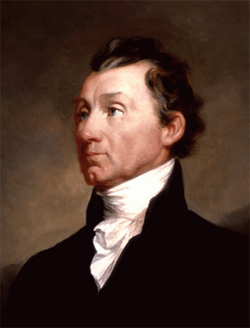 (For those of you who were doodling or passing notes to your boy/girlfriend during history class, President James Monroe announced in December 1823 that the United States wouldn’t tolerate foreign powers interfering in the affairs of Western Hemisphere nations. While it doesn’t come up often in everyday conversation, the Monroe Doctrine was a major moment in U.S. foreign policy.)
(For those of you who were doodling or passing notes to your boy/girlfriend during history class, President James Monroe announced in December 1823 that the United States wouldn’t tolerate foreign powers interfering in the affairs of Western Hemisphere nations. While it doesn’t come up often in everyday conversation, the Monroe Doctrine was a major moment in U.S. foreign policy.)
And so with great pomp and fanfare, it was announced that the American Historical Revue and Motion Picture Exposition would be held in Los Angeles from July 2 through August 6, 1923.
 It was like standing on the dock and waving as the Titanic set sail. Because everything about this world’s fair was doomed from the very beginning.
It was like standing on the dock and waving as the Titanic set sail. Because everything about this world’s fair was doomed from the very beginning.
For starters, some Hollywood whiz kid came up with this promotional brainstorm: they would get the U.S. Mint to make a special commemorative half dollar coin. That had been done for the Chicago and San Francisco world’s fairs; why not for Hollywood’s?
Problem was, Congress had to approve the limited edition coin. And given Hollywood’s sinking popularity, Congress was understandably reluctant to fling its arms around the movie industry.
Things were complicated by a simple question: just what the heck did the Monroe Doctrine have to do with Hollywood, the motion picture business, or anything in particular? It looked exactly like what it was: blatant exploitation. Vermont Senator Frank Greene put it in typically blunt New England terms: “The question is whether the United States government is going to … submit its coinage to this, well, harlotry.” (Harlotry is a polite way of saying prostitution, in case you wondered.)
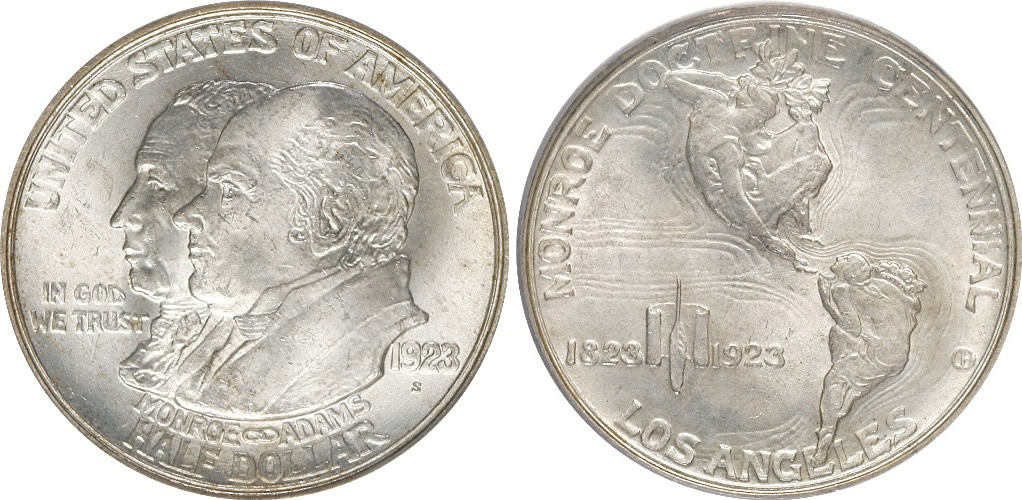 So the moguls sprinkled lots of money around Capitol Hill, and -viola!- Congress approved the silver 1923 Monroe Doctrine Centennial Half Dollar. It ordered 274,077 to be struck at the San Francisco mint and sold them for $1 each, with the government getting fifty cents for the cost of the coin, and the organizers keeping the other fifty cents to cover exposition expenses. (Think of it as a kind of government-sponsored fundraiser.)
So the moguls sprinkled lots of money around Capitol Hill, and -viola!- Congress approved the silver 1923 Monroe Doctrine Centennial Half Dollar. It ordered 274,077 to be struck at the San Francisco mint and sold them for $1 each, with the government getting fifty cents for the cost of the coin, and the organizers keeping the other fifty cents to cover exposition expenses. (Think of it as a kind of government-sponsored fundraiser.)
 The special half dollar stumbled coming out of the starting gate. The designer of the seal for the 1901 Buffalo World’s Fair (where President McKinley was shot, by the way) threw a major fit, claiming the coin’s reverse stole his copyrighted design. Though nothing came of his protests, the seal and the coin’s reverse do look an awful lot alike.
The special half dollar stumbled coming out of the starting gate. The designer of the seal for the 1901 Buffalo World’s Fair (where President McKinley was shot, by the way) threw a major fit, claiming the coin’s reverse stole his copyrighted design. Though nothing came of his protests, the seal and the coin’s reverse do look an awful lot alike.
Even worse, the public didn’t buy the half dollar. By opening day, a mere 27,000 had been sold. (The remaining 447,000 coins were eventually dumped into general circulation, infuriating the folks who had paid a buck for theirs.)
 Worse still, the public just didn’t go to the fair. Located in Exposition Park, right next to the brand-new Los Angeles Coliseum, the organizers tried to make things interesting. Different historically-themed live shows were featured nightly, such as “Montezuma and the Fall of the Aztecs.”
Worse still, the public just didn’t go to the fair. Located in Exposition Park, right next to the brand-new Los Angeles Coliseum, the organizers tried to make things interesting. Different historically-themed live shows were featured nightly, such as “Montezuma and the Fall of the Aztecs.”
But it turned out nobody cared about the Aztecs. Or history, for that matter. The few attendees who did show up were more interested in seeing movie stars in the flesh than watching a recreation of the Aztecs.
Clearly, organizers hadn’t done their marketing homework ahead of time. They had projected one million people would visit the fair. Barely 300,000 attended – and it only hit that number because free tickets were given to tens of thousands of teenagers in the closing weeks.
 The movie moguls remained optimistic right up to the bitter end, because they had one last ace in the hole. President Warren Harding was scheduled to visit the fair on August 6. That, they confidently believed, would drive a late spike in visitation.
The movie moguls remained optimistic right up to the bitter end, because they had one last ace in the hole. President Warren Harding was scheduled to visit the fair on August 6. That, they confidently believed, would drive a late spike in visitation.
And it might have … if Harding hadn’t died suddenly in San Francisco on August 2, four days before his planned appearance. The last hope of the fair amounting to anything died with him.
And so they called, “That’s a wrap!” on the American Historical Revue and Motion Picture Exposition. In one final insult, when they closed the books for the last time, the fair had lost money.
It was a total flop from beginning to end.
Hollywood eventually climbed out of its funk, firmly establishing itself as America’s leading family-friendly entertainment medium for the next 40 years. But the 1923 Hollywood World’s Fair had nothing to do with it.
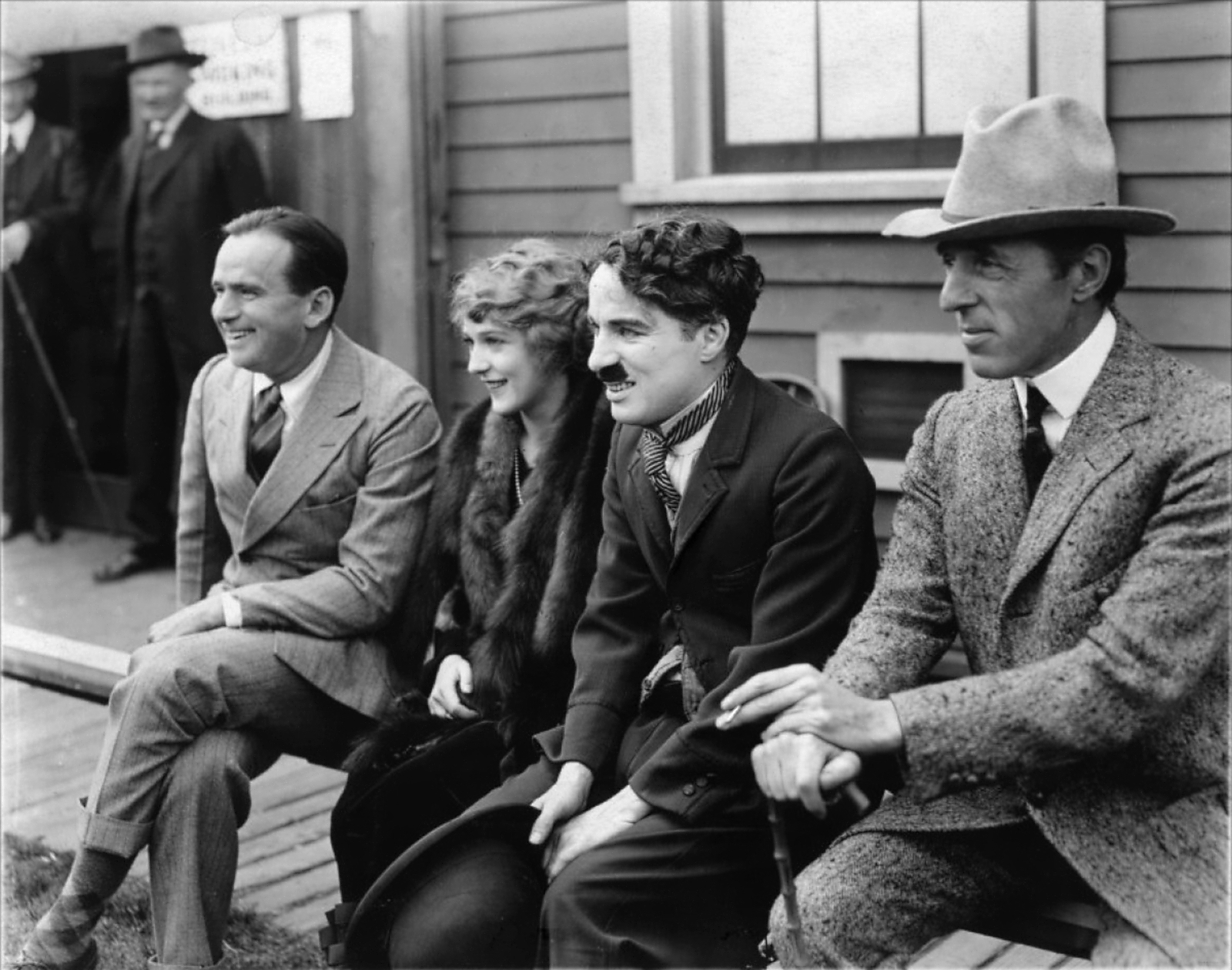 The moral of this story is painfully simple: if you want to overhaul the image you project to the public, hosting a gaudy, four-week pat on the back isn’t the way to do it.
The moral of this story is painfully simple: if you want to overhaul the image you project to the public, hosting a gaudy, four-week pat on the back isn’t the way to do it.
Did you find this enjoyable or helpful? Please continue to join me each week, and I invite you to read Tell it Like Tupper and share your review!
Curious about Tell It Like Tupper? Here’s a chance to see for yourself. Take a sneak peek at a couple chapters in this free downloadable excerpt.

